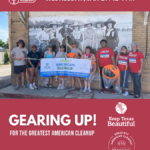This blog was written by Jessica Lerner, a digital marketing professional and a new social impact entrepreneur, about her experience working within her community to create change. Her current projects include Real Parks, an international parks directory encouraging conservation, and Jess Lerner Art, a photographic coastal art brand supporting efforts to clean our oceans.
Jessica is passionate about improving our communities for future generations, and she is a recent graduate of Arizona State University’s Executive Master of Sustainability Leadership program. If you have questions or would like to work with Jessica, email her at hello@jesslerner.com or visit jesslerner.com. Follow Jessica’s work and connect with her on LinkedIn.
I am no longer accepting the things I cannot change. I am changing the things I cannot accept.
Angela Y. Davis

Change is hard. While it is difficult to change ourselves, it is almost impossible to change others. So, when issues arise in our communities, what should we do? How can we approach our leaders and create change?
I stumbled on some of the answers during a campaign to save recycling in my county and learned a few tips to create change from ASU’s sustainability leadership master’s program. The great news is, the steps to create change worked for me! I know they will work for you, too.
A year ago, my county, Okaloosa County, Florida, voted to discontinue our recycling program over rising recycling expenses. Each household would need to pay approximately $1 per household per month to continue to recycle, and our commissioners didn’t think we would pay. So, they voted against it. However, we convinced our leaders to reverse their decision and successfully saved our recycling program for 32,500 households. We successfully kept over a million pounds of recycling out of the landfill. The following steps demonstrate how we did it.
Step 1: Analyze the Situation & Create or Harness Urgency
Local news stations were the first to break the news about our recycling program coming to an end. I began seeing dozens of residents comment online about how upset and angry they were. As heated as everyone appeared to be, it isn’t easy to get an accurate understanding of public opinion from a few comments. Immediately, I joined the conversation online and asked if anyone had created a petition. After speaking to a few people and searching online for one to no avail, I volunteered to create one.
Step 2: Create a Petition to Quantify Public Opinion
I chose the Change.org platform and created a simple petition outlining the problem and linked to the news articles about the situation. I also added a video to the header explaining the situation and added our county commissioners’ email addresses to notify them every time a resident signed. View our petition here.
Step 3: Reach out to Community Leaders to Ask for Help
Creating the petition and sharing it with a few people was not enough, though. We needed to quickly reach thousands of people if our campaign to save recycling was going to work.
I reached out to admins of local Facebook groups to ask them to share the petition. I also reached out to individuals on the NextDoor app, and met with local environmental groups in person to request their support. I am sure they also reached out to other groups, which is excellent! One person can help spark change, but we cannot create change alone.
Step 4: Keep the Momentum Going through Email
Through the Change.org platform, I emailed everyone who signed the petition almost daily to encourage them, let them know how many people had signed since the day before, and to remind them to continue to share the petition on their social media profiles and with other local groups. Keeping the momentum going was crucial to our success.
Step 5: Attend Local Commission Meetings
We also found out when the next public commission meeting was and shared that information via email. Many of us went in person to speak to our commissioners on a few different occasions. While the sheer numbers on our petition were impressive, hundreds of recycling supporters showing up at commission meetings was equally persuasive.
Rachel Hering, the Keep Texas Recycling Program Director, recommends finding the agenda for your upcoming council and commission meetings online. If there’s something that you’re passionate about, even if it’s not recycling, you should consider attending to have your voice heard.
Success!
Eventually, our petition to save recycling worked. One month after our leaders chose to end our recycling program, they held an emergency revote and reinstated recycling.
While we could have called our county commissioners repeatedly, picketed, or tried to persuade them with facts about our trash problem in the U.S., I do not think that approach would have worked. Our leaders want to get re-elected, they want to keep the majority of people in the community happy, and they are ultimately in power to serve us. If we can prove that our community wants change, our leaders will listen.
I summarized our campaign to save recycling below. Please reach out if you have additional questions. Good luck creating change in your community!

Steps to Create Change
-
Create or harness urgency.
- Did something happen recently to spark public outrage?
- If so, harness that passion for creating change.
- If not, help create urgency by contacting local news organizations. Send them pictures and data about the issue. Press coverage helps.
2. Create a petition to quantify public opinion.
Change.org worked best for us.
- Use a short, catchy headline.
- Stick to the facts.
- Link to articles that corroborate the story.
- Add an appropriate video to the header for attention.
- Add decision-makers email addresses to the petition.
3. Reach out to community leaders and ask them to share the petition.
- Find local environmental groups on Facebook.
- Reach out to local news organizations.
- Share the petition with groups on the NextDoor app.
- If you can find additional media outlets and ways to reach your community, that’s wonderful! The more people you can enlist to help, the better.
4. Keep the momentum going with email or SMS.
- Encourage supporters and provide them with campaign updates.
- Thank supporters for their help and remind them to continue to share the petition.
5. Attend local meetings with leaders and encourage others to join you.
- Attend meetings with community leaders (most meetings are open to the public) and share the data with local officials.
- You may have to attend multiple meetings since change takes time. Don’t get discouraged!


